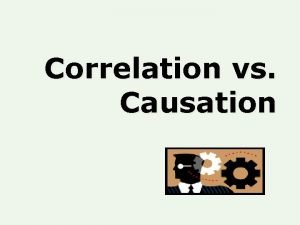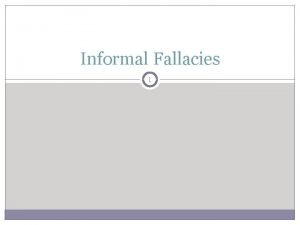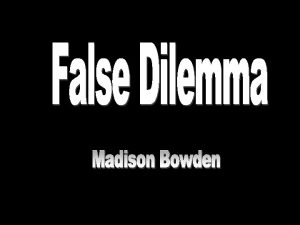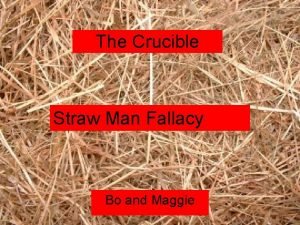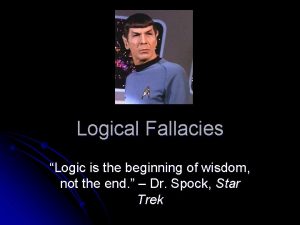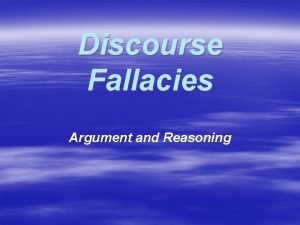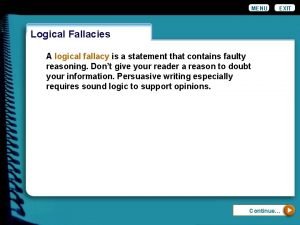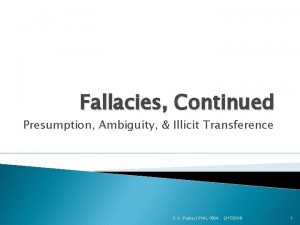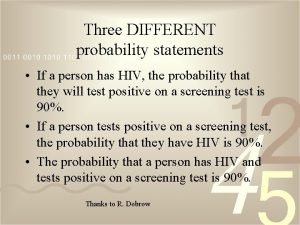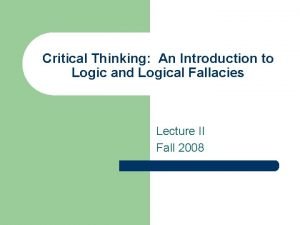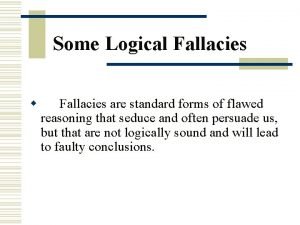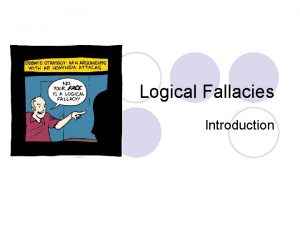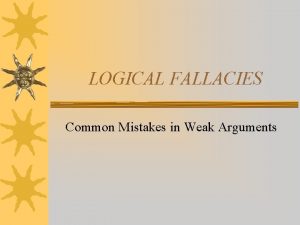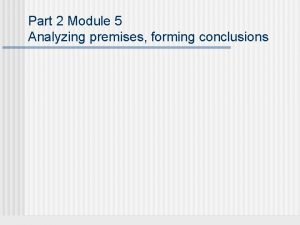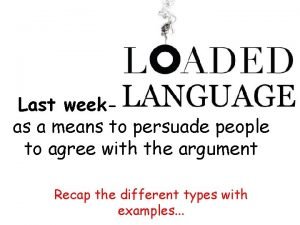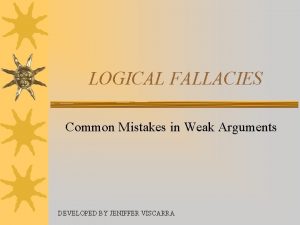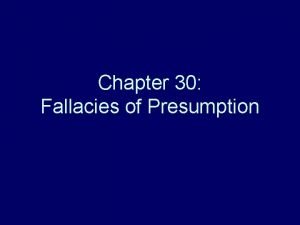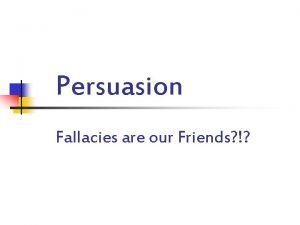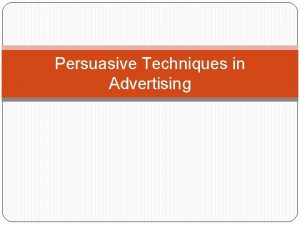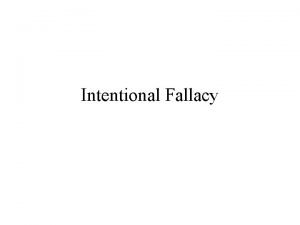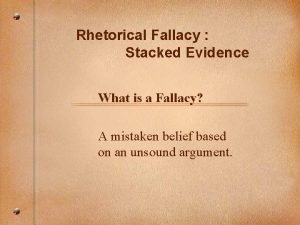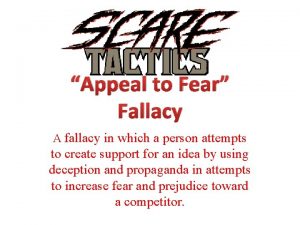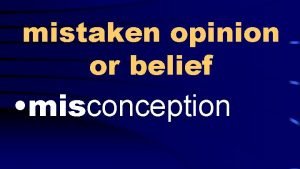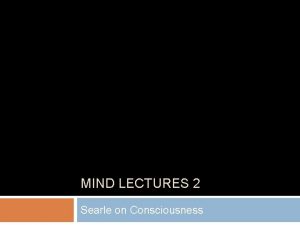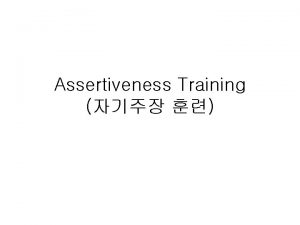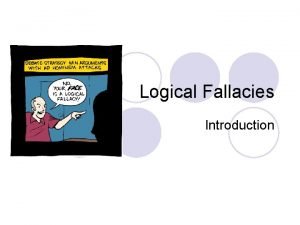Fallacy What is a fallacy Fallacy A mistaken













































- Slides: 45

Fallacy

What is a fallacy? �Fallacy: A mistaken belief, usually based on an unsound argument A failure in reasoning Mistakes made by the human brain while arguing �There are hundreds of types of fallacies

Top Ten Fallacies Ad hominem 1. 2. 3. Victim Blaming Appeal to fear Scare tactic False Dichotomy Aka false dilemma (Either – or) 4. 5. Hasty Generalization Non-sequitur 6. 7. Strawman Red Herring 8. 9. 10. “Does not follow” Slippery Slope Circular Reasoning False Analogy (Apples & oranges) Cherry Picking

1. Ad Hominem Personal attack

1. Ad hominem (Personal attack) �The “You. Tube Comments Section” of fallacies �Involves attacking the person who made the claim rather than the argument/claim itself. Logical form: Person 1 is claiming Y. Person 1 is a moron. Therefore, Y is not true. • This does not address the validity of claim Y, it instead attacks the person

1. Ad hominem - Example � Example 1: � Jimi Hendrix died of a drug overdose, so his music is worthless. Problem: his death has nothing to do with his music, music quality is based more in the traits of the music than the traits of the musician

1. Ad hominem – Blaming the Victim � Blaming the Victim is a type of ad hominem It is an the attempt by the attacker to escape responsibility by placing the blame for the crime or other abuse at the hands of the victim. ▪ Problem: trying to find some sort of personal fault with the victim rather than addressing the actual crime that took place � Example: I was mugged! ▪ Well, you were wearing a nice suit; you were asking for it ▪ Maybe if you presented yourself in a way that was better suited to your environment you wouldn’t have been mugged

2. Appeal to fear AKA Scare tactics

2. Appeal to Fear � A favorite fallacy for politicians � When fear, not based on evidence or reason, is being used as the primary motivator to get others to accept an idea, proposition, or conclusion. An attempt to control what people think by exaggerating fear/hysteria Not used when there is actual, present, measurable danger ▪ Ex: If there’s a fire and you’re yelling “fire!” to get people out of the building, that doesn’t count as a fallacy � Logical Form: If you don’t accept X as true, something terrible will happen to you. Therefore, X must be true.

2. Appeal to Fear examples � How to spot an appeal to fear � Think in terms of probabilities, not possibilities. � Anything is possible, including a lion busting into your home at night and mauling you to death -- but it is very, very improbable. � People who use fear to manipulate you, count on you to be irrational and emotional rather than reasonable and calculating. Prove them wrong. � Have you ever seen the threat level at less than Orange?

Appeal to Fear examples �Sex Ed in Mean Girls If you have sex, you will get pregnant and die!

Appeal to Fear – Ahmed the clockmaker

5. Appeal to Fear examples � Anti-Communist hysteria during the HUAC hearings � Anti-witch hysteria during the Salem Witch Trails.

3. False Dichotomy Aka “False dilemma” Either – Or fallacy

3. False Dichotomy �Involves presenting only two outcomes when many more outcomes are possible. Makes it seem like there are only two options when in reality there are many different options �Logical Form: Either X or Y is true.

3. False dichotomy � Problem: More options exist The customer could want to help but not have an extra 15 dollars Not donating money doesn’t automatically mean you hate children

3. False Dichotomy

4. Strawman “That’s not what I said. ”

9. Strawman � Another favorite for politicians � Substituting a false or exaggerated claim for the opponent's actual argument A straw man is what happens when a person misrepresents another person's position, making it easier to attack. � Logical Form 1. Person A has position X. 2. Person B, instead of looking at the actual claim of position X, presents position Y (which is a distorted version of X- not what Person A originally argued). 3. Person B attacks position Y. 4. Therefore X is false/incorrect/flawed.

9. Strawman Example � For example, "Senator Jones says that we should not fund the attack submarine program. I disagree entirely. I can't understand why he wants to leave us defenseless like that. " � In this example, Senator Jones' position is misrepresented as one that wants to leave the country defenseless. The antagonist is making the assertion that: "Do not fund the attack submarine program" = "Leave the country defenseless. " However the two statements are not equal, and it takes more work to argue against the former statement than the latter. In other words, it's much easier to attack the proposition "Let's leave the country defenseless" than "Don't fund the submarine program. "

9. Strawman Examples �Examples: - I know I forgot to deposit the check into the bank yesterday. But, nothing I do pleases you. Person A asked about the bank, they did not say that “nothing person B did pleases them” �- We should let the banks fail for their bad practices. RH: Yes, but in tough economic times, we need to stand behind our leadership. This does not address the banks, it changes the claim to have something to do with supporting the leadership

5. Red Herring Or avoiding the question

5. Red Herring �Changing the topic so you don’t have to answer a question or debate a claim; a distraction usually made in attempt to: ▪ distract the other person ▪ dodge a question ▪ change the subject. Logical form: 1. Topic A is under discussion. 2. Topic B is introduced under the guise of being relevant to topic A (when topic B is actually not relevant to topic A). 3. Topic A is abandoned.

5. Red Herring � Example #1: � Mike: It is morally wrong to cheat on your spouse, why on earth would you have done that? Ken: But what is morality exactly? Mike: It’s a code of conduct shared by cultures. Ken: But who creates this code? . . . � Problem: Ken has successfully derailed this conversation off of the topic of him cheating to the deep, existential, discussion on morality. His cheating is not addressed- he hasn’t answered the question Example #2 Daughter: "I'm so hurt that Todd broke up with me, Mom. " Mother: "Just think of all the starving children in Africa, honey. Your problems will seem pretty insignificant then. “ � Problem: Attention is shifted away from the daughter’s pain so the parent does not have to comfort her

6. Hasty Generalization Jumping to conclusions Argument from small numbers

6. Hasty Generalization � Drawing a conclusion based on a small sample size, rather than looking at statistics that are much more in line with the typical or average situation. Small sample size Too few observations Insufficient data Not enough evidence gathered ▪ Jumping to conclusions � Logical Form: ▪ Sample S is taken from population P. Sample S is a very small part of population P. Conclusion C is drawn from sample S.

6. Hasty Generalization - Examples � � � Example #1: My father smoked four packs of cigarettes a day since age fourteen and lived until age sixtynine. Therefore, smoking really can’t be that bad for you. Problem: It is extremely unreasonable (and dangerous) to draw a universal conclusion about the health risks of smoking by the case study of one man. � � Example #2: Four out of five dentists recommend Happy Glossy Smiley toothpaste brand. Therefore, it must be great. � Problem: It turns out that only five dentists were actually asked. When a random sampling of 1000 dentists were polled, only 20% actually recommended the brand. The four out of five result was not necessarily a biased sample or a dishonest survey, it just happened to be a statistical anomaly common among small samples.

7. Non Sequitur Does not follow

7. Non Sequitur �Description: When the conclusion does not follow from the premises. In more informal reasoning, it can be when what is presented as evidence or reason is irrelevant or adds very little support to the conclusion. �Logical Form: �Claim A is made. �Evidence is presented for Claim A. �Therefore, claim C is true.

7. Non-Sequitur � � Example #1: People generally like to walk on the beach. Beaches have sand. Therefore, having sand floors in homes would be a great idea! � Explanation: As cool as the idea of sand floors might sound, the conclusion does not follow from the premises. The fact that people generally like to walk on sand does not mean that they want sand in their homes, just like because people generally like to swim, they shouldn’t flood their houses. � � Example #2: Buddy Burger has the greatest food in town. Buddy Burger was voted #1 by the local paper. Therefore, Phil, the owner of Buddy Burger, should run for President of the United States. � Explanation: I bet Phil makes one heck of a burger, but it does not follow that he should be President.

Non Sequitur – Slippery Slope �Another type of non-sequitur is the Slippery Slope, a fallacy in which a person asserts that some event must inevitably follow from another without any argument for the inevitability of the event in question. Usually uses the phrase “Then What? _______!? ” Or “Next thing you know… _______” �Logical Form: �If A, then B, then C, . . . then ultimately Z!

Slippery Slope Example: � We cannot unlock our child from the closet because if we do, she will want to roam the house. If we let her roam the house, she will want to roam the neighborhood. If she roams the neighborhood, she will get picked up by a stranger in a van, who will sell her in a sex slavery ring in some other country. Therefore, we should keep her locked up in the closet. � Problem: In this example, it starts out with reasonable effects to the causes. For example, yes, if the child is allowed to go free in her room, she would most likely want to roam the house -- 95% probability estimate[1]. Sure, if she roams the house, she will probably want the freedom of going outside, but not necessarily “roaming the neighborhood”, but let’s give that a probability of say 10%. Now we start to get very improbable. The chances of her getting picked up by a stranger (. 05%) in a van (35%) to sell her into sex slavery (. 07%) in another country (40%) is next to nothing when you do all the math: � . 95 x. 10 x. 0005 x. 35 x. 0007 x. 4 = about 1 in 25, 000. � Morality and legality aside, is it really worth it to keep a child locked in a closet based on those odds?

More Slippery Slope Examples: You should never gamble. � If we pass laws against Once you start gambling fully-automatic weapons, you find it hard to stop. then it won't be long Soon you are spending before we pass laws on all your money on all weapons, and then we gambling, and eventually will begin to restrict you will turn to crime to other rights, and finally support your earnings. we will end up living in a communist state. Thus, we should not ban fullyautomatic weapons.

8. Circular Reasoning Aka “Begging the question”

8. Circular Reasoning �Involves relying on the original statement as proof of the statement itself; offers no evidence to support the statement Uses conclusions to support assumptions that were necessary to make those conclusions �Logical Form: X is true because of Y because Y is true because of X.

8. Circular Reasoning examples � Example 1: Only an untrustworthy person would run for president. The fact that politicians are untrustworthy is proof of this. Problem: the claim relies on its own premise - "politicians are untrustworthy“ - to support its original claim that only untrustworthy people run for president � Example 2: � A non-smoker says, "Can a person quit smoking? Of course -- as long as he has sufficient willpower and really wants to quit. " Problem: Essentially says, "he can quit if he can" Would need to address issues such as overcoming addiction and legitimate strategies for successfully quitting

9. False Analogy Apples & Oranges

9. False Analogy �This fallacy consists in assuming that because two things are alike in one or more respects, they are necessarily alike in some other respect. Logical Form: ▪ A has property X. B has Property X. A and B must also both have property Y.

9. False Analogy Examples � Employees are like nails. Just as nails must be hit in the head in order to make them work, so must employees. � Problem: Employees are not like nails in this situation. Hitting them on the head could injure them so that they don’t get more work done. Problem: Even though the animal fits the criteria, it is not the same. It actually poses a danger to the flock.

9. False Analogy Examples �Weed killer has dihydrogen monoxide Weed killer is poisonous ▪ Therefore, dihydrogen monoxide is poisonous �Dihydrogen monoxide = H 20 = water

10. Cherry picking Aka suppressed evidence

10. Cherry Picking �When only select evidence is presented in order to persuade the audience to accept a position, and evidence that would go against the position is withheld. The stronger the withheld evidence, the more fallacious the argument. �Logical Form: Evidence A and evidence B is available. Evidence A supports the claim of person 1. Evidence B supports the counter claim of person 2. Therefore, person 1 presents only evidence A.

10. Cherry Picking Examples: � My political candidate gives 10% of his income to the needy, goes to church every Sunday, and volunteers one day a week at a homeless shelter. Therefore, he is honest and morally sound. � Problem: What information was left out of the example is that this same candidate gives 10% of his income to needy prostitutes in exchange for services, goes to the bar every Sunday after church (and sometimes before), and only works at the homeless shelter to get clients for his drug dealing business.

10. More Cherry Picking Examples: �Using this data you gathered, but leaving the rest out

A few others…. �Appealing to False Authority: Using dubious sources to support your point A clearly biased source (often use their own fallacies) �Bandwagon “Do it and your cool!” Well, everyone else was doing it too…
 Correlation mistaken for causation
Correlation mistaken for causation Falacia de conclusión irrelevante
Falacia de conclusión irrelevante Jekyll and hyde symbolism
Jekyll and hyde symbolism Ad hoc fallacy
Ad hoc fallacy False dichotomy definition
False dichotomy definition Mathematical fallacy
Mathematical fallacy Straw man fallacy in the crucible
Straw man fallacy in the crucible Is ethos a logical fallacy
Is ethos a logical fallacy Pathetic fallacy in julius caesar
Pathetic fallacy in julius caesar Apple polishing fallacy
Apple polishing fallacy Hasty generalization logical fallacy
Hasty generalization logical fallacy Argumentum ad populum
Argumentum ad populum Ad baculum fallacy definition
Ad baculum fallacy definition Slippery slope fallacy definition
Slippery slope fallacy definition I love you
I love you Fallacy in a sentence
Fallacy in a sentence False dilemma fallacy
False dilemma fallacy Simile the moon glowed like
Simile the moon glowed like Red herring fallacy
Red herring fallacy Prosecutor’s fallacy
Prosecutor’s fallacy Contoh circulus in probando
Contoh circulus in probando Kabiri kapsalon
Kabiri kapsalon Frankenstien chapter 13
Frankenstien chapter 13 Prejudicial language fallacy
Prejudicial language fallacy Pre trans fallacy
Pre trans fallacy False equivalence fallacy
False equivalence fallacy Fallacy
Fallacy Pathetic fallacy vs personification
Pathetic fallacy vs personification Equivocation fallacy
Equivocation fallacy False dichotomy fallacy
False dichotomy fallacy A christmas carol introduction lesson
A christmas carol introduction lesson Flawed logic definition
Flawed logic definition Appeal to ridicule example
Appeal to ridicule example Fallacy of inverse
Fallacy of inverse Undistributed middle fallacy
Undistributed middle fallacy What is loaded words
What is loaded words What is false analogy
What is false analogy Fallacy vsb
Fallacy vsb Naturalistic fallacy definition
Naturalistic fallacy definition Fallacies of presumption
Fallacies of presumption Hasty generalization examples
Hasty generalization examples Persuasive techniques bandwagon
Persuasive techniques bandwagon Ad pupulum
Ad pupulum Existential fallacy
Existential fallacy Valid generalization examples
Valid generalization examples Pathetic fallacy vs personification
Pathetic fallacy vs personification
